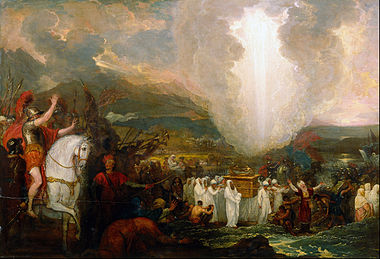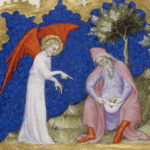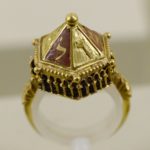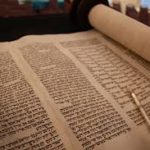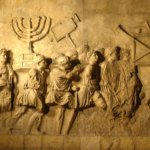The Ark of the Covenant is one the most well known, and perhaps one of the most mysterious artifacts of the Jewish and Christian religions. When the Babylonians destroyed Jerusalem in 586 BCE, the whereabouts of the Ark became a mystery. Perhaps it was carried away from Jerusalem in advance of the arrival of the Babylonians, and hidden in an undisclosed location. Perhaps it was destroyed along with the rest of Jerusalem. Some would use Revelation 11:19 (see footnote 1) to argue that the Ark of the Covenant was brought up into heaven. Archaeologists dismiss the latter possibility and embrace the hope that it is still intact, hidden in a cave or buried somewhere.
The plot of Steven Spielberg’s 1981 film Raiders of the Lost Ark revolves around a race between America’s Indiana Jones and Hitler’s Nazis to unearth the Ark of the Covenant. Aside from the fact that it is an ancient artifact of great historical significance, why is there such a fascination with finding the lost ark? To answer that question it is important to know what the Ark actually is, and what it’s significance was to the early Hebrew people.
Moses delivered the Israelites out of bondage in Egypt
After Moses has delivered the Israelites out of bondage in Egypt, God calls upon him to go to the top of Mount Sinai where he will be instructed about the ways in which the Israelites are to worship. It is here that God gives Moses the instructions to build the Ark, which will serve as a guide and protector for the Israelites in their journey to the promised land.
In Exodus 37 the Ark is described as being a chest made of acacia wood; two and a half cubits ling, a cubit and a half wide, and a cubit and a half high (44 x 26 x 26 in.). The inside and outside were overlaid with pure gold. Two gold rings were attached to each side of the Ark. Poles made of acacia wood and overlaid with gold were put through the rings to carry it. A mercy seat made of pure gold was placed on top of the Ark. The mercy seat had two gold cherubim, one on each end, facing each other. The cherubim’s wings were outstretched over the mercy seat. After God gives them instructions for the construction of the Ark, he tells Moses to put the covenant (the ten commandments) inside it (see footnote 2) .
He then tells Moses:
There I will meet with you, and from above the mercy seat, from
between the two cherubim that are on the ark of the covenant, I will
deliver to you all my commands for the Israelites (Ex. 25:22).
Here, Moses learns one of the purposes of the Ark: as a place to receive God’s commands. But the Ark would also serve other purposes. For one, it would be a guide to the Israelites in the wilderness. Numbers 10:33 says:
So they set out from the mount of the Lord three days’ journey with
the ark of the covenant of the Lord going before them three days’
journey, to seek out a resting place for them.”
Passing the Jordan River
Then later, in the book of Joshua, we read that the Ark was used to part the waters of the Jordan River so that the Israelites could pass through:
So when those who bore the ark had come to the Jordan, and the feet
of the priests bearing the ark were dipped in the edge of the water,
the waters flowing from above stood still, rising up in a single
heathen the people crossed over opposite Jericho. Josh 6: 15,16
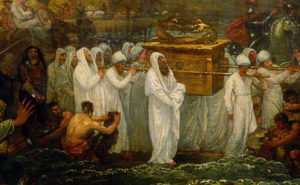 Another purpose of the Ark is that is served as a military tool; a means of ensuring victory against Israel’s enemies. In Numbers 10:35, we read that Moses sings a song whenever the Ark set out: “Arise O Lord, let your enemies be scattered, and your foes flee before you.” And Joshua used the Ark’s great power in his conquest of Canaan, completely destroying nation after nation. With the Ark is in their possession, Israel seemingly couldn’t lose. As Indiana Jones says in Raiders of the Lost Ark, “An army which carries the Ark in front of it is invincible.”
Another purpose of the Ark is that is served as a military tool; a means of ensuring victory against Israel’s enemies. In Numbers 10:35, we read that Moses sings a song whenever the Ark set out: “Arise O Lord, let your enemies be scattered, and your foes flee before you.” And Joshua used the Ark’s great power in his conquest of Canaan, completely destroying nation after nation. With the Ark is in their possession, Israel seemingly couldn’t lose. As Indiana Jones says in Raiders of the Lost Ark, “An army which carries the Ark in front of it is invincible.”
But was it this chest made of acacia wood and gold that held all of this awesome power? Or was the Ark merely a physical symbol representing God’s presence and his great power to the Israelites? Obviously it was the latter. There was nothing inherent in the Ark that guaranteed it’s possessors great military strength and protection. It was God alone who used his power to protect his righteous people and not the Ark. However, when his people no longer live up to their end of the covenant, God withholds his protection, regardless of their possession of the Ark. We see this illustrated in the book of Samuel.
The Philistines made war with the Israelites who, at this time, were not obedient to God. In the first battle, the Philistines defeated the Israelites, killing 4,000 men. The Israelites retrieved the Ark of the Covenant from Shiloh, assuming that having the Ark would assure them a dominating victory. But Israel lost the next battle as well, this time losing 30,000 men, and losing the Ark to the Philistines. (I Sam. 4:1-11)
With the Ark in the possession of the Philistines, interesting things happened. Up until this point in the Bible, the presence of the Ark has either been associated with helping the Israelites in righteous times or dormancy in wicked times. But in the presence of the Philistines, God uses the Ark for what appears to be practical jokes. When the Philistines place the Ark in the temple of their god Dagon, the next morning they discover the idol fallen upon his face in front of the Ark, mockingly bowing down. After returning Dagon to his pedestal, they come back the next morning to find it in the same position as before, but this time with its head and hands broken off. God then steps it up a notch: afflicting the people with tumors, and plaguing them with mice. Learning their lesson, the Philistines returned the Ark to Israel. (1 Sam. 5,6)
This account in 1 Samuel shows that the powers of Israel’s God that are manifest by means of the Ark of the Covenant can be detrimental if is lies in the wrong hands. This is a lesson that seemed to elude the Nazis in Raiders of the Lost Ark. In the movie, Hitler, at the height of his power, desperately wants to obtain the Ark; ironically wanting to use a Jewish artifact in his quest for world domination. Indiana Jones’ Egyptian sidekick Sallah is wary of finding the Ark. “There is something that troubles me,” he says to Indie. “If the Ark is there at Tannis, then it is something that man was not meant to disturb. Death has always surrounded it. It is not of this earth.”
In the film’s climax, when the Nazis open the Ark, we see the wrath of God in all it’s glory. Holy fire skewers the bad guys and melts the flesh from off of their bones. When all is said and done, absolutely nothing is left of them; kind of like Herem.
Footnotes
1. “Then God’s temple in heaven was opened, and the ark of his covenant was seen within his temple: and there were flashes of lightning, rumblings, peals of thunder, an earthquake, and heavy hail.” New Revised Standard Version
2. Along with the tablets of the covenant, we also learn that the Ark contained a golden urn of manna (food that God provided for the Israelites in the wilderness) and Aaron’s rod “that budded” (Heb. 9:4).

